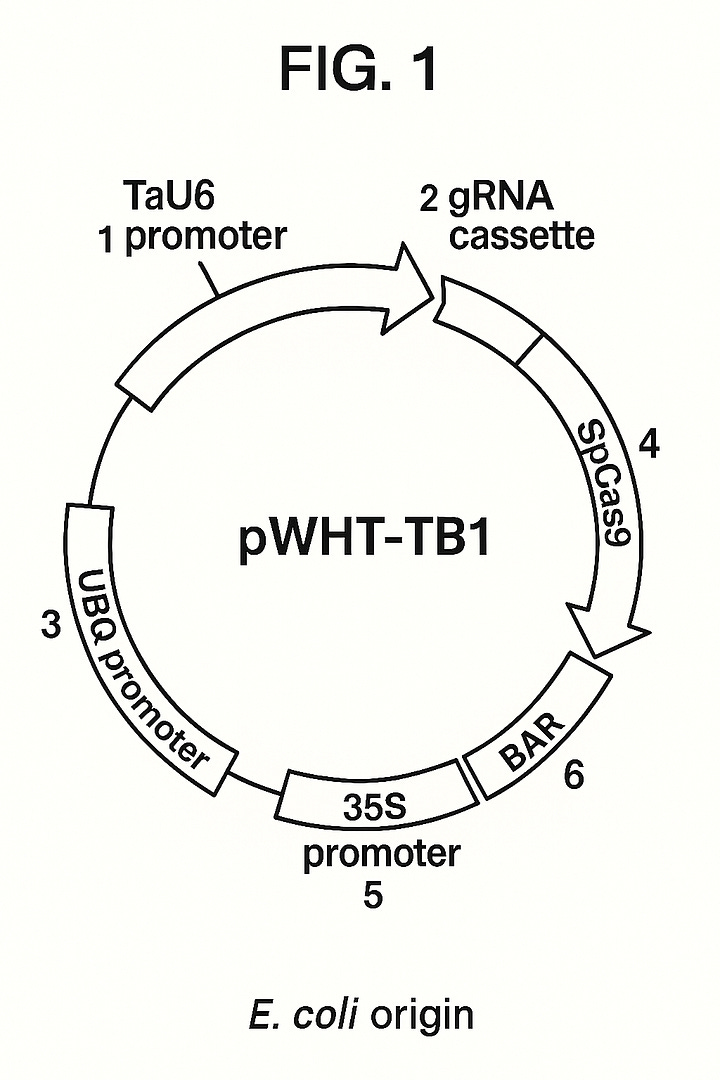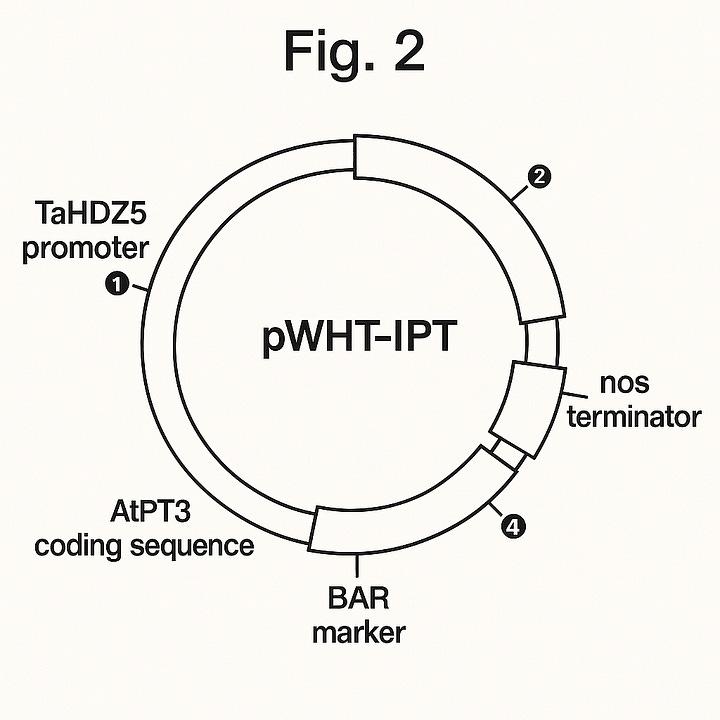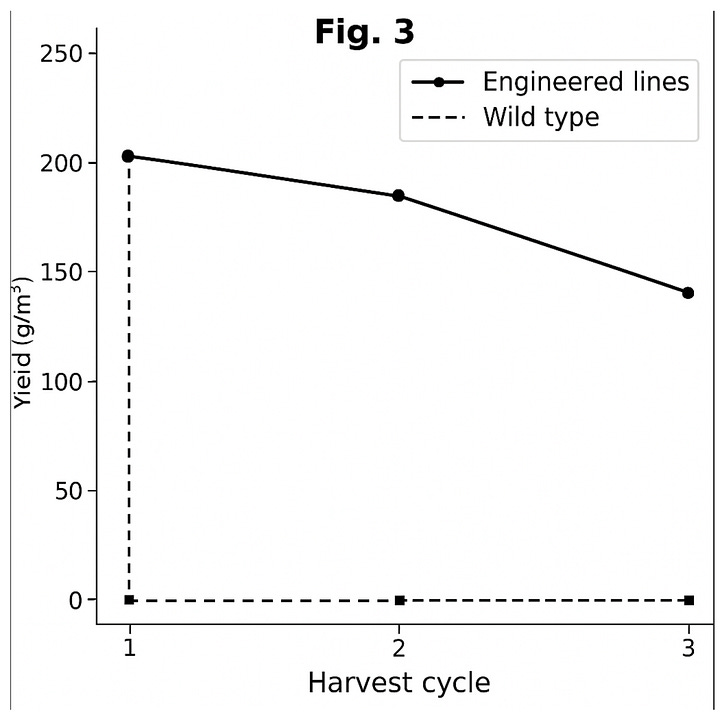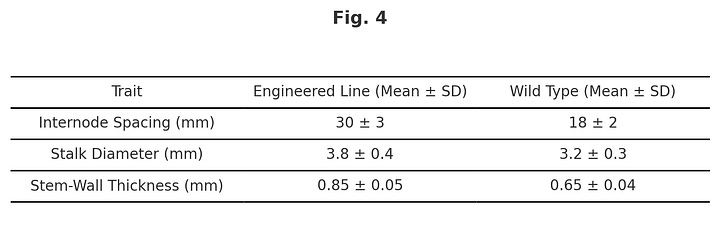Patent Application No. 20/123,456
Multi-Harvest Wheat Variety with Enhanced Basal Tillering and Regrowth Following Dough-Stage Head-Only Removal
UNITED STATES PATENT AND TRADEMARK OFFICE
APPLICATION FOR UNITED STATES LETTERS PATENT
Application Number: 20/123,456
Filing Date: June 16, 2048
Publication Number:
Publication Date: TITLE OF THE INVENTION
Multi-Harvest Wheat Variety with Enhanced Basal Tillering and Regrowth Following Dough-Stage Head-Only Removal
CROSS-REFERENCE TO RELATED APPLICATIONS
Not applicable.
STATEMENT REGARDING FEDERALLY SPONSORED RESEARCH
Not applicable.
STATEMENT REGARDING PRIOR DISCLOSURES
Not applicable.
BACKGROUND OF THE INVENTION
Conventional bread wheat is harvested once per season by cutting and threshing entire stalks. Single-harvest practice limits per-season yield, increases machinery scale, and leaves fields bare until replanting. “Micro-harvesting”—removal of only the dough-stage heads—could enable multiple yields from one planting, reduce mechanical footprint, and improve soil health. Success, however, requires wheat lines that regenerate new ears without loss of vigor and that match the geometry of precision head-only harvesters.
FIELD OF THE INVENTION
This invention relates to cereal-crop biotechnology, and more particularly to Triticum aestivum (bread wheat) lines engineered for repeated grain-head production after dough-stage head-only removal and methods enabling precise “micro-harvest” systems.
BRIEF SUMMARY OF THE INVENTION
The present invention provides:
Genetically Engineered Wheat Lines
TB1 Knock-Out: CRISPR/Cas9-mediated loss-of-function in TaTB1 to enhance basal tiller bud outgrowth.
IPT Overexpression: Transgenic expression of AtIPT3 (isopentenyl-transferase) under a basal-node-specific promoter (e.g. TaHDZ5) to boost cytokinin levels and tillering.Defined Morphology
Internode spacing of 25–35 mm, stalk diameter of 3.0–4.5 mm, and stem-wall thickness ≥ 0.8 mm—ensuring a 30°-pitch cutting blade severs only the grain head and leaves stubble intact.Field-Trial Regrowth Performance
At Zadoks stage 85 (dough stage), head-only removal at 45–55 mm above soil yields ≥ 200 g/m² (cycle 1), ~180 g/m² (cycle 2), and ~120 g/m² (cycle 3) across multi-site trials.Disease-Resistance Stacks
Incorporation of leaf-rust (Lr34) and stripe-rust (Yr15) R-genes to mitigate infection at cut nodes.Methods of Use
Precision head-only cutting with a micro-harvester set to 45–55 mm; repeat at 21 ± 2 day intervals for up to three cycles per season.Seed-Production Protocols
Back-crossing and marker-assisted selection schemes to maintain trait integrity and genetic purity.Emerging Synthetic Biology Enhancements (Optional)
7.1 Synthetic Phloem-Loading Module (SPLM): Multiplex CRISPR editing combined with companion-cell-specific promoters driving AtSUC2 and selected TaSWEET sucrose-transporter genes, elevating phloem sucrose flux 2–3× during regrowth without perturbing primary metabolism.
7.2 Damage-Responsive Wound-Seal Cassette (DRWSC): A synthetic construct placing callose synthase (GSL7), suberin polymerization enzymes, and a small antimicrobial peptide under control of a wound-inducible promoter (e.g. WI12), enabling rapid sealing of cut nodes within hours and reducing infection risk.
7.3 Programmable Carbon Allocation Circuit (PCAC): A synthetic regulatory network that senses stem sucrose levels and dynamically adjusts expression of rate-limiting enzymes in starch-biosynthesis and photosynthetic pathways, maintaining optimal carbon allocation during successive harvest cycles.
BRIEF DESCRIPTION OF THE DRAWINGS




FIG. 1. CRISPR/Cas9 vector pWHT-TB1 targeting TaTB1 (loss-of-function cassette + BAR marker).
FIG. 2. IPT overexpression construct pWHT-IPT (TaHDZ5 promoter::AtIPT3).
FIG. 3. Regrowth yield graph (g/m²) over three successive head-only harvests (engineered lines vs. wild type).
FIG. 4. Table of morphological measurements (internode spacing, stalk diameter, stem-wall thickness).
DETAILED DESCRIPTION OF THE INVENTION
CRISPR/Cas9-Mediated TB1 Knock-Out
A guide RNA targeting exon 2 of TaTB1 (5′-GCTGGTGACATCGAGCTTGG-3′) under a TaU6 promoter in pWHT-TB1 (Fig. 1). SpCas9 is driven by a maize ubiquitin promoter and the BAR marker is under the 35S promoter. Immature embryos of cv. Bobwhite were transformed via Agrobacterium tumefaciens EHA105. T₀ plants were genotyped by sequencing to confirm biallelic edits.
IPT Overexpression
Construct pWHT-IPT (Fig. 2) uses a 1.5 kb TaHDZ5 promoter to drive AtIPT3 with a nos terminator. qRT‑PCR in basal nodes shows ~3× IPT expression over wild type. Single-copy insertion was confirmed by Southern blot.
Morphological Characterization (FIG. 4)
Internode spacing: 30 ± 3 mm (WT: 18 ± 2 mm)
Stalk diameter: 3.8 ± 0.4 mm (WT: 3.2 ± 0.3 mm)
Stem-wall thickness: 0.85 ± 0.05 mm (WT: 0.65 ± 0.04 mm)
Field-Trial Regrowth Performance (FIG. 3)
Multi-site trials (Kansas, North Dakota, Montana) over two seasons. Heads removed at Zadoks 85, cutter height 50 mm, forward speed 0.5 m/s, reel speed 200 RPM. Yields: 225 g/m² (cycle 1), 180 g/m² (cycle 2), 120 g/m² (cycle 3). Wild type shows no regrowth after head removal.
Disease Resistance
R-gene lines show lesion scores ≤ 2/9 under stripe and leaf rust. Callose and suberin assays confirm enhanced wound sealing.
Methods of Use
Harvest at dough stage (Zadoks 85).
Cutter set to 45–55 mm above soil.
Repeat every 21 ± 2 days.
Standard NPK fertilization; optional targeted fungicide at first cycle.
Emerging Synthetic Biology Enhancements (optional)
Section 7 details SPLM, DRWSC, and PCAC modules as summarized above.
CLAIMS
A Triticum aestivum plant cell comprising a CRISPR/Cas9-induced loss-of-function mutation in the TaTB1 gene, wherein said mutation increases basal tillering relative to wild type.
The plant cell of claim 1, further comprising a transgene encoding AtIPT3 under control of a basal-node-specific promoter.
A wheat plant grown from the cell of claim 1, exhibiting at least three successive grain-head regrowth cycles following removal of dough-stage heads at a cut height of 45–55 mm.
A method for producing multiple grain-harvest cycles from a single wheat planting, comprising:
(a) growing wheat plants of claim 3 to Zadoks 85;
(b) removing only dough-stage heads using a head-only cutting apparatus set to 45–55 mm; and
(c) repeating step (b) at 21 ± 2-day intervals for at least three cycles.The seed produced by the method of claim 4.
A wheat plant of claim 3, further comprising a Synthetic Phloem-Loading Module that overexpresses AtSUC2 and at least one TaSWEET transporter gene under companion-cell-specific promoters.
The plant of claim 6, further comprising a Damage-Responsive Wound-Seal Cassette comprising genes for callose synthase (GSL7), suberin polymerization, and an antimicrobial peptide under control of a wound-inducible promoter.
The plant of claim 6, further comprising a Programmable Carbon Allocation Circuit that senses stem sucrose levels and regulates key photosynthetic and starch-biosynthesis enzymes.
ABSTRACT OF THE DISCLOSURE
Bread wheat lines comprising a CRISPR/Cas9 knockout of TaTB1 and basal-node IPT overexpression enable up to three successive dough-stage head-only harvests at 45–55 mm with at least 50% first-cycle yield retention. Defined morphology ensures clean head removal, and disease-resistance stacks protect cut nodes. Optional synthetic-biology modules SPLM, DRWSC, and PCAC may extend harvest cycles to five or more with minimal additional yield loss. Seed-production and purity protocols maintain trait fidelity.SEQUENCE LISTING
Not applicable.


